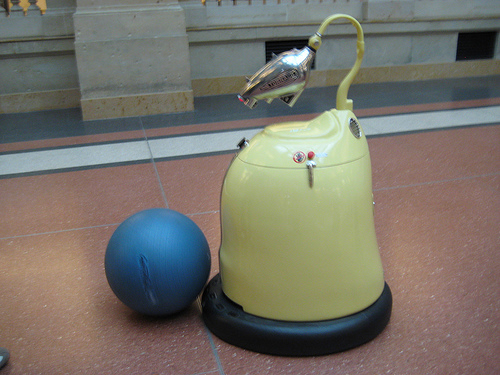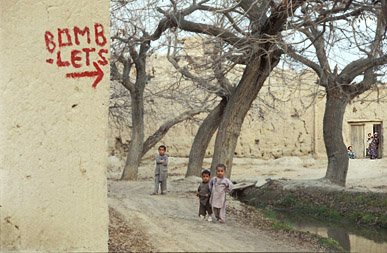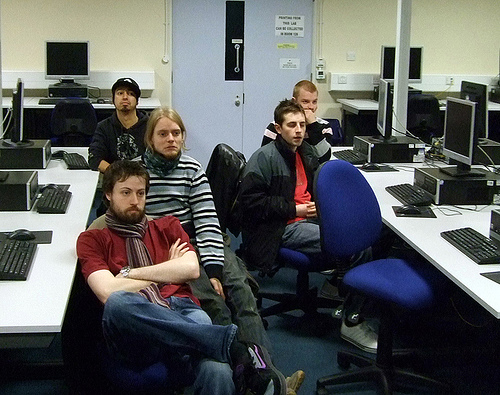A new guest post from Jenny Hughes on identities.
“Well here I am again in Bremen, squatting on Graham’s blog. He’s abandoned me on a key board while he has gone out for a pizza and, much as I dislike blogging, I dislike pizza even more – always reminds me of a picture of food on a plate.
This is the second time this week I have swapped identities with Graham. I think. On Thursday evening he was invited to a fashion show and disco. Fortunately for all those of you have seen him dance or noticed his taste in clothes, this all took place in Second Life. So there we were, sitting in a bar, laptop, fags and beer at the ready and Graham hands over the keyboard on the grounds that I’m better at talking rubbish and faster at typing drivel than he is.
Now whose identity am I taking over? And come to think of it, who am I? His 2L ID is Graham Lightfoot (in his dreams), a superhero lookalike who for the occasion was dressed in gimpy black leathers with definite shoulder pads (the embarrassment of it!). So I played at being Jenny Hughes being Graham Attwell being Graham Lightfoot for a while then I thought it would be more fun being my own SL identity being Graham Lightfoot being the first life Graham Attwell who was, at that moment, Jenny Hughes. Keep up. I also have another first life identity (for particular writing purposes) and she has a second life ID as well. And I am a virtual student who I teach and she is someone else in SL. Maybe I should have invited them all along, just to see what dialogue my fingers wrote.
Do I have an identity crisis? Well I guess it depends on which one of me you are asking.
So all this gets us into late-night, beer-fuelled conversations about identities – justified as ‘research’ for a forthcoming project on ‘Identities’. Now my job at Pontydysgu is to generate ideas on demand and turn up occasionally for which I get paid in beer. It’s a good system, 1 idea = 1 beer, or, if pushed, 1000 words = 1 beer. (I’m thinking about having a word with my union rep to see if I can get on to a fixed rate of 1 hour = 1 beer.) My starting point when Graham says I want 2 ideas by tomorrow is always to grope around my brain to see if I can recycle anything still alive in there. I think it’s called re-purposing. Unfortunately my brain is a bit like my handbag – filled with all sorts of junk I carry around just in case it comes in useful. And there, like the toffee in the bottom of my handbag-brain, I unearthed a rather squashed memory about Erving Goffman’s “dramaturgical approach”. It took me a while to get pick the fluff off – it was, after all, 1959 when he wrote his blockbuster “The Presentation of Self in Everyday Life’ and I had read it as a student back in the 60’s.
(Why should novelists have blockbusters and academics have to make do with Seminal Works, I ask??)
One of the things I like about the dramaturgical approach is that it looks at context rather than behaviour. I like the Wikipaedia explanation
“In this sense, dramaturgy is a process which is determined by consensus between individuals. Because of this dependence on consensus to define social situations, the perspective argues that there is no concrete meaning to any interaction that could not be redefined.”
The core of Goffman’s thinking was that a person’s identity is not a stable and independent psychological entity; it is constantly remade as the person interacts with others.
Sweet. And seems to me as good a starting point for looking at identities as any.
Now a great many of you sociologist-types will be very familiar with all his stuff, given that Goffman was one of the most influential sociologists of the 20th century, but for the rest of you and Graham, here are some sound bites.
Goffman had lots of ‘bits’ in his theory, some bits are more applicable to identities issues than others.
He makes heavy use of metaphors and looks at communication and social interaction as if it was a theatrical performance. He argues that there are 7 elements to a performance. So, in no particular order:
The front or ‘the mask’ is a standardized, generalizable and transferable way for the performer to control the manner in which the audience perceives him. I would say this could be an avatar, a login name or whatever. Just go to the chat rooms to look at some of the more off the wall names, especially when you just know that Hunkybeast and Lionking are 5 foot nothing, scrawny little men who wear string vests.
Mystification refers to the concealment of certain information from the audience and why this is done. So Hunkybeast is often a bit economical with the truth about his wife and 5 kids.
Dramatic realization is the selection of aspects of the performer that he wants the audience to know. For instance, when projects, as a matter of course, set up communication platforms on their web sites I remember being outraged that they even suggested I put up a photograph or told people who my friends were. Even now, I tend to select out more aspects of myself than maybe Graham. Though of course it depends on the context and certainly changes with my identities – on Facebook I’m happy to fill in every quiz going to find out and share with the world ‘What sort of Drunk Am I?’.
Idealization. A performance often presents an idealized view of the situation to avoid confusion (misrepresentation) and strengthen other elements. So the way I write this blog is different from the way I write an academic paper, partly because the style reaffirms it is a blog but also suggests that there is actually a human being behind the performance who is ….(I was going to say warm, funny, witty, interesting, gorgeous but Graham said …..) a small grumpy troll.
Maintenance of expressive control is about the extent to which people stay in character. I am truly ace at this. I have complete on-line alter ego who not only has a complete identity but he or she (giving nothing away) also has an identity in SL, makes spelling mistakes and typos I don’t make, uses a different vocabulary and different sentence construction and different abbreviations (yeah, I was a linguist in a previous life. That’s without the detail of their ‘life’.
Finally, the needs to be a level of belief by those playing the part in the parts they are playing. This may be high or low, total or partial, cynical or authentic etc. I sometimes have a sneaky suspicion that Graham believes he really is a broad shouldered super-hero lookalike in first life as well as second.
Please, all you purists, don’t write and tell me that this is not at all what Goffman meant. I am only borrowing some ideas with a view to a bit of ‘re-purposing.’ There are lots more bits I think are useful in Goffman’s ideas but this blog entry is getting way too long and I’m getting hungry.
In particular I’d like to have look at what he said about ‘stages’ – back stage, front stage and off-stage, about ‘roles’ and about ‘secrets’ and how this connects with stuff I am playing with on learning ‘narrative’ (watch this space). At the moment I’m not sure if I can do anything useful with these ideas but I’d love to know whether anyone else sees any potential in them in providing a framework for exploring ‘identities’.
PS I’ve just counted Goffman’s elements and I’ve only talked about 6 because I can’t remember the seventh. Anyone who can fill the blank?”



